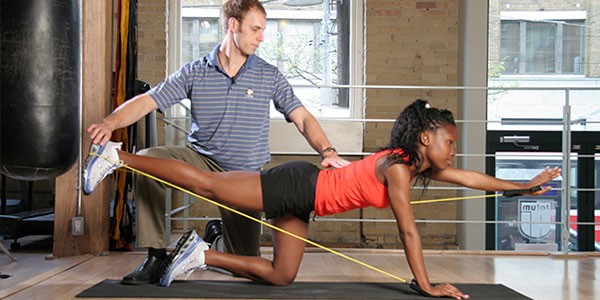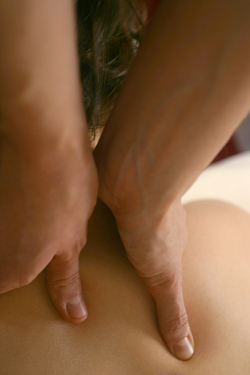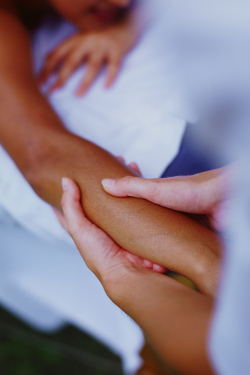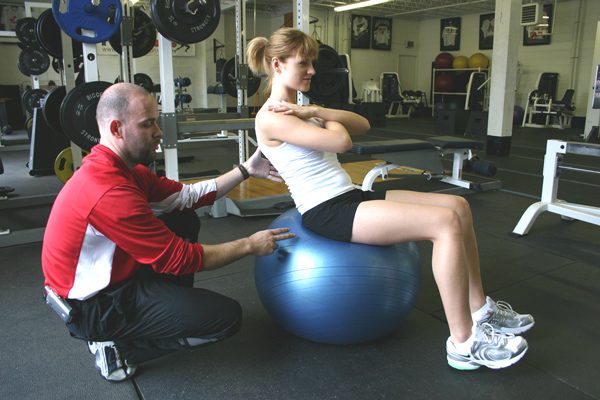Julie Harder is going exactly where her passion takes her.

The personal fitness trainer and Shiatsu therapist has a thing for transforming her clients into healthier people. This year she will run a marathon alongside one of her clients. First he has to lose 65 pounds and build up his cardiovascular fitness, but watching him advance toward his goal will be the best part. “It’s amazing watching people progress and feel better about themselves. You can actually see their attitude change,” she says.

Julie’s career as a personal fitness trainer began eight years ago when she was in her last year of university. A health science major at the University of Waterloo, Julie says she has always been interested in the body. After graduation, she passed the American Council on Exercise (ACE) certification exam, an internationally recognized test for health and fitness professionals. From there, she decided to expand her business by training in Shiatsu therapy, a Japanese form of massage. She has also traveled to Thailand where she learned to do Thai massage, a form of bodywork using yoga postures.
By offering a combination of fitness training and massage, Julie has managed to build her business to about 60 clients. Her business also works because she can take her skills on the road. Literally. Everyday Julie packs a massage table into her car and spends the day visiting clients in their homes to help them with a workout or a massage. Most days start at 7am with an early morning fitness client. The day winds down in the evening, sometimes not until 9pm, with massage treatments. It’s a long and tiring day, but Julie says it’s worth it. “I’m my own boss. I could never go to work for anybody else now.”
She also has breaks during the day that she can use for her own free time. She will often squeeze in a workout, run errands or do her grocery shopping. There are downsides, however. Zipping around from client to client means she has to deal with city traffic every day. Going to people’s homes poses a potential safety issue, although Julie says she hasn’t had any problems. “I build my business through referrals, but it’s always in the back of your mind that you have to go to a stranger’s house.” There’s also the possibility that she could get injured and not be able to work. The wear and tear of massage work means she often has sore wrists and problems with tendonitis.
“They say in this industry that a therapist has about seven years of work so you have to take that into account and be willing to learn other modalities such as nutrition or fitness training. That’s what saves me, I can bounce between the two,” she says.
 Julie’s line of work means she also misses out on corporate perks such as health coverage and vacation pay. She also has the constant worry of keeping enough clients to pay the rent. “That’s a big fear always. But that pushes you and makes you active in getting referrals and getting people to make their appointments.” Despite the downside to the business, Julie doesn’t see these risks in a negative light but rather as a challenge. “I love being my own business person. Yes, there is risk, but it opens me up to other possibilities.”
Julie’s line of work means she also misses out on corporate perks such as health coverage and vacation pay. She also has the constant worry of keeping enough clients to pay the rent. “That’s a big fear always. But that pushes you and makes you active in getting referrals and getting people to make their appointments.” Despite the downside to the business, Julie doesn’t see these risks in a negative light but rather as a challenge. “I love being my own business person. Yes, there is risk, but it opens me up to other possibilities.”
She also loves the social aspect of training. “I love meeting people and building relationships because everybody has a great story. People really open up to me because I deal with issues of the body and there’s touch involved, people trust me. It’s very fulfilling to build relationships like that.”
The typical route into the personal fitness training industry is through academic training and certification. It is possible to do the certification on its own, but most employers require academic training in the form of a related university degree or college diploma. Courses related to fitness training such as science, physiology, kinesiology, fitness and lifestyle management or physical education would all provide a good background. There are different certification levels so you will have to decide which is most recognized in your area and among the clientele that you want to work with. The best way to determine this is to ask local community and fitness centres for recognized programs in your city or province.
Julie’s shiatsu training through the Shiatsu School of Canada in Toronto was a two-year diploma program that she estimates cost about $20,000. While she was at school Julie continued her work as a personal trainer on the side and put in about 25 hours a week with clients.

Once you’ve graduated from a fitness program and have your certification you can begin training at a fitness club. Rates are dependent on expertise, location and target market. If you’re just starting out, you can expect to make about $25 a session. The gym will usually take a cut of about 50 per cent. As you increase your training and get more clients, you can raise your rates. You can also start training people in their homes so you don’t have to pay the gym a percentage.
“You have to be very motivated to get clients. The gyms don’t help you with this,” Julie says. Usually people who also have training in massage can get clients from their fitness training pool. It’s also possible to take your work to the corporate sector as large companies employ massage and fitness professionals for employee health programs.
The most important ingredient for success in the industry is caring about people. “If you’re not willing to give something of yourself, you won’t succeed. You really have to pour yourself into helping people. You also have to be interested in the body and how it works and have a passion for learning and wanting to change,” Julie says.

Comments are closed.